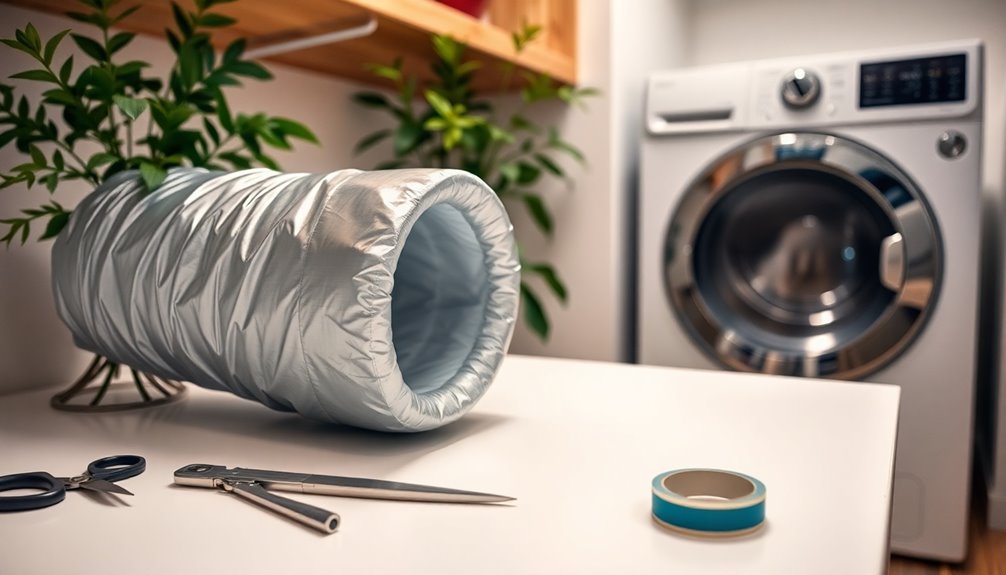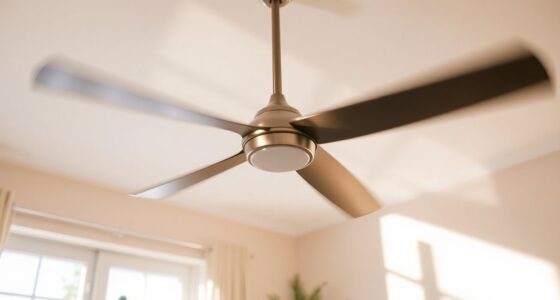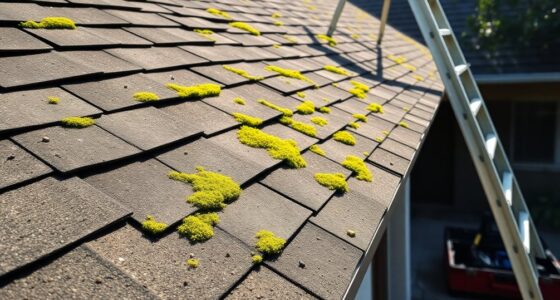Insulating your dryer vent is essential for energy efficiency and moisture control. Start by choosing fire-resistant materials like fiberglass or foam board. Install insulated ducting, especially in unconditioned spaces, to prevent heat loss and condensation buildup. Guarantee smooth metal ducts for better airflow and reduce lint accumulation. Regularly inspect and clean your vent to eliminate lint and maintain peak performance. Don't forget to check for any damage to insulation as well. This simple process can save you on energy bills while extending your dryer's lifespan. Want more tips on maximizing your dryer's efficiency? Just keep going!
Key Takeaways
- Choose fire-resistant insulation materials like fiberglass or mineral wool to enhance safety and prevent fire hazards in dryer vents.
- Opt for insulated ducting specifically designed for dryer vents in unconditioned spaces to improve energy efficiency and airflow.
- Maintain a clear airspace between insulation and the metal vent pipe to prevent heat retention and ensure proper ventilation.
- Regularly clean the dryer vent at least once a year to eliminate lint buildup and improve airflow, reducing fire risks.
- Inspect insulation for damage or compression periodically, ensuring it remains effective and preventing moisture-related issues like mold growth.
Importance of Dryer Vent Insulation
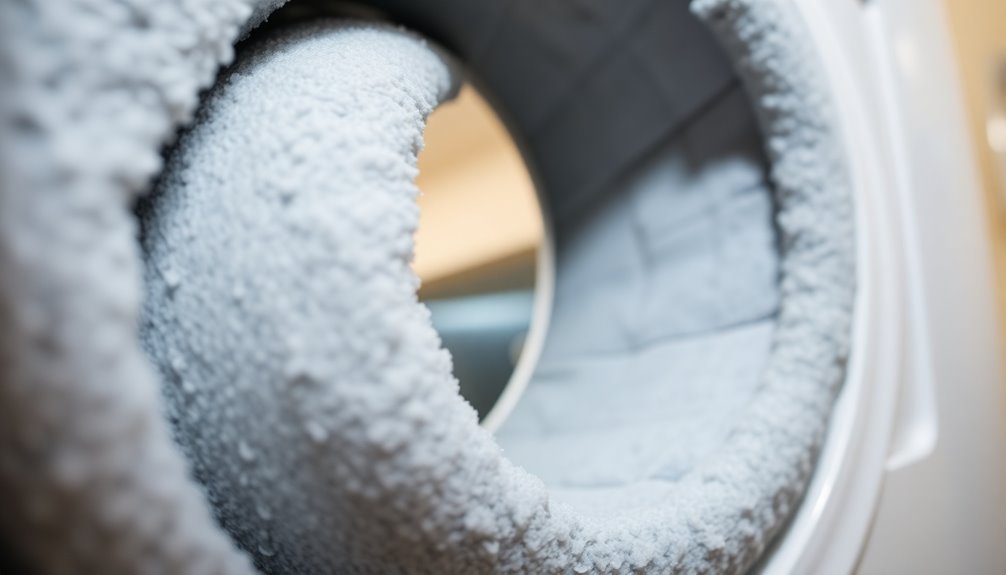
When it comes to maintaining a safe and efficient home, insulating your dryer vent is essential. Proper insulation around the dryer vent helps prevent condensation buildup, which can lead to moisture issues and mold growth, especially in colder climates.
By insulating your dryer vent, you enhance energy efficiency, reducing heat loss during drying cycles and ultimately lowering your energy bills. Insulation also keeps cold air from entering the duct when the dryer's off, maintaining peak performance.
Plus, well-insulated dryer vents minimize lint accumulation and blockages, greatly reducing the fire hazard associated with dryer-related fires. Using materials like fiberglass or rigid insulation can provide added fire-resistant properties, ensuring safety in case of heat exposure.
Types of Insulation Materials
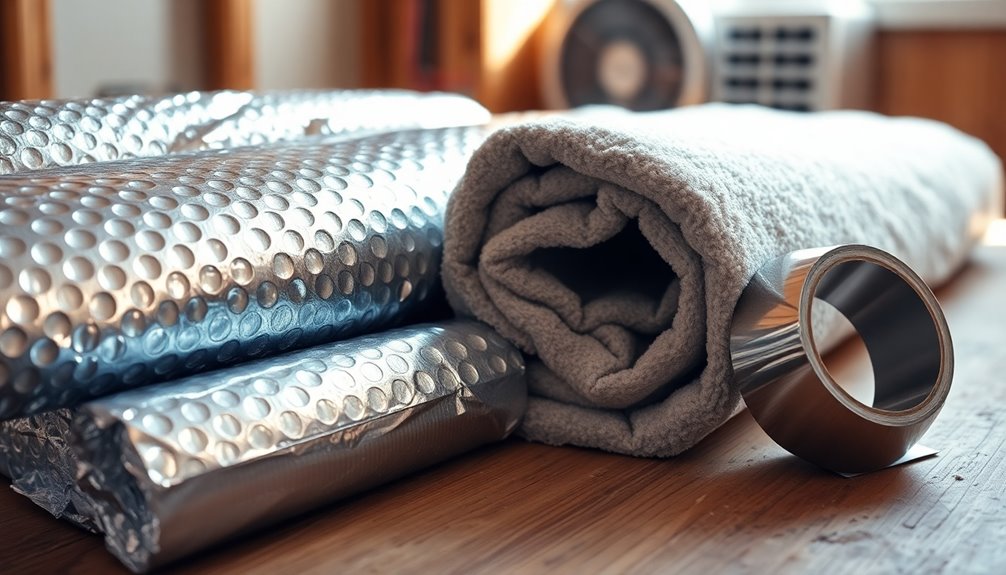
Insulating your dryer vent effectively requires choosing the right materials for the job. Here are three popular insulation materials to reflect upon:
- Fiberglass Insulation: Cost-effective and fire-resistant, this option should have the paper facing away from the vent to minimize fire risks.
- Foam Board Insulation: Rigid and moisture-resistant, it's perfect for unconditioned spaces, preventing condensation and heat loss.
- Mineral Wool Insulation: Known for its fire-resistant and soundproofing properties, it's ideal for enhancing safety around dryer vents.
When selecting insulation materials, ascertain they allow for proper air flow while providing the necessary protection.
Using a flexible duct can help maintain efficiency and accommodate any bends in your venting system.
Installation Best Practices

To guarantee your dryer vent insulation is effective and safe, it's essential to follow best installation practices.
Use high-temperature materials like fiberglass or Roxul insulation to withstand heat without compromising safety. Opt for insulated ducting specifically designed for dryer vents, especially in unconditioned spaces like attics, to minimize heat loss and condensation.
Ascertain there's a clear airspace between the insulation and the metal pipe to prevent heat retention that could lead to fire hazards. Choose smooth metal ducts over flexible ones for better airflow and reduced lint buildup.
Secure all connections with 4-inch clamps to prevent leaks. Finally, regularly inspect the insulation for wear and clean the dryer vents at least once a year to maintain efficiency.
Maintenance and Safety Tips

Maintaining your dryer vent is essential for both safety and efficiency. Regular upkeep helps prevent lint buildup, a major cause of dryer fires.
Here are three key maintenance tips to keep in mind:
- Clean your dryer vent at least once a year to eliminate lint and enhance airflow.
- Inspect insulation regularly to verify it's not damaged or compressed, which can lead to heat retention and fire hazards.
- Use fire retardant insulation materials like fiberglass or Roxul, and verify they don't touch the dryer vent pipe, maintaining an air gap for safety.
Additionally, keep an eye out for moisture or mold growth, as improper insulation can lead to condensation issues. Proper maintenance can also help reduce fire hazards associated with lint buildup, ensuring your appliance operates safely and efficiently.
Prioritizing these steps verifies your dryer vents operate safely and efficiently.
Energy Efficiency Benefits
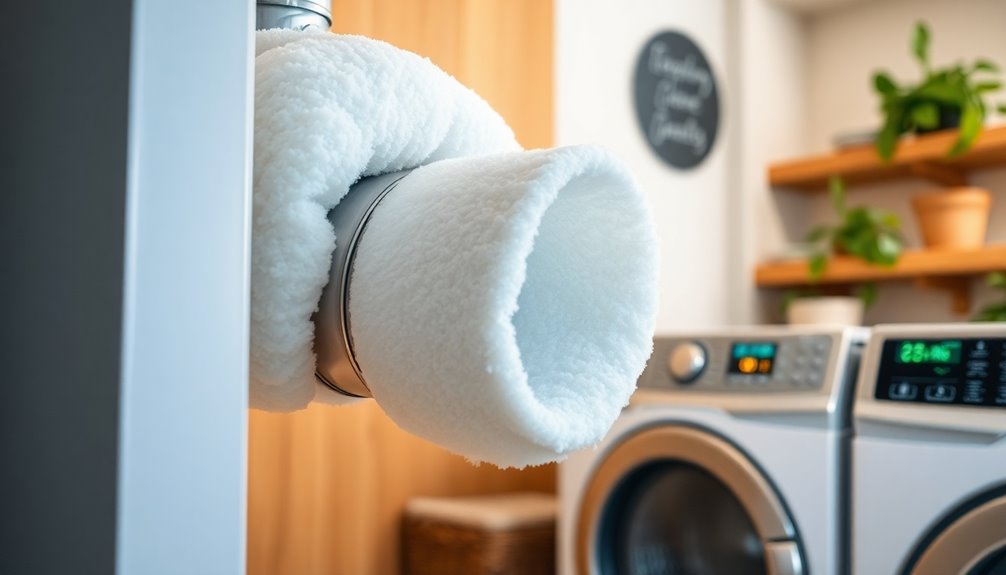
When you insulate your dryer vent, you can markedly boost its energy efficiency, especially in colder climates. By reducing heat loss during drying cycles, you could lower your energy bills by 10-30%.
Properly insulating the vent helps maintain ideal temperatures, enhancing dryer efficiency and cutting drying times by up to 20%. Additionally, insulated ducts minimize condensation buildup, preventing moisture-related issues like mold growth that can lead to costly repairs and decreased efficiency.
Using insulated ducting designed for dryer vents guarantees effective operation, maintaining airflow and preventing lint accumulation that hinders performance.
Regular maintenance and insulation improvements can also extend your dryer's lifespan, saving you money on replacements and repairs in the long run.
Frequently Asked Questions
How to Insulate Your Dryer Vent?
To insulate your dryer vent, start by using insulated ducting designed for this purpose. It helps prevent heat loss and condensation.
If you've got existing metal ducts, wrap them with insulation to boost thermal performance.
Make sure to apply insulation in unconditioned spaces like attics, keeping it away from the duct to avoid fire hazards.
Finally, regularly check the insulation for lint buildup to maintain safety and efficiency.
How Do I Keep Cold Air From Coming in My Dryer Vent?
To keep cold air from coming in your dryer vent, start by installing insulated ducting designed for dryer vents.
Use a reliable flapper cover or check valve at the exit to block cold drafts when the dryer isn't running.
Make sure the duct is sealed properly, especially in unconditioned spaces.
Regularly inspect and clean the vent to avoid blockages, and consider switching to rigid metal ducting to minimize leaks.
How Can I Make My Dryer Vent More Efficient?
To make your dryer vent more efficient, use rigid metal ducting instead of flexible ducting to reduce lint buildup and improve airflow.
Keep the total vent length to a maximum of 12 feet and limit bends to one 90-degree elbow.
Regularly clean the vent system at least once a year to eliminate lint accumulation.
Installing a quality flapper cover can also help prevent cold air from entering when the dryer isn't in use.
What to Wrap a Dryer Vent With?
When you're looking to wrap your dryer vent, consider using insulated ducting specifically designed for this purpose.
It's essential to choose materials that can withstand high temperatures, like Roxul insulation, which is fire-resistant.
You should avoid plastic or flimsy aluminum ducts; instead, go for heavy-duty, UL-listed aluminum foil ducts.
Just make sure the insulation doesn't obstruct airflow and maintains proper clearance from the vent pipe to prevent any fire hazards.
Conclusion
To sum up, insulating your dryer vent is a smart move that can save you time, energy, and money. As the saying goes, "a stitch in time saves nine." By taking these simple steps to insulate, you're not only enhancing your dryer's efficiency but also ensuring safety and prolonging its lifespan. So, don't wait—get started today and enjoy the benefits of a well-insulated dryer vent! Your future self will thank you.
